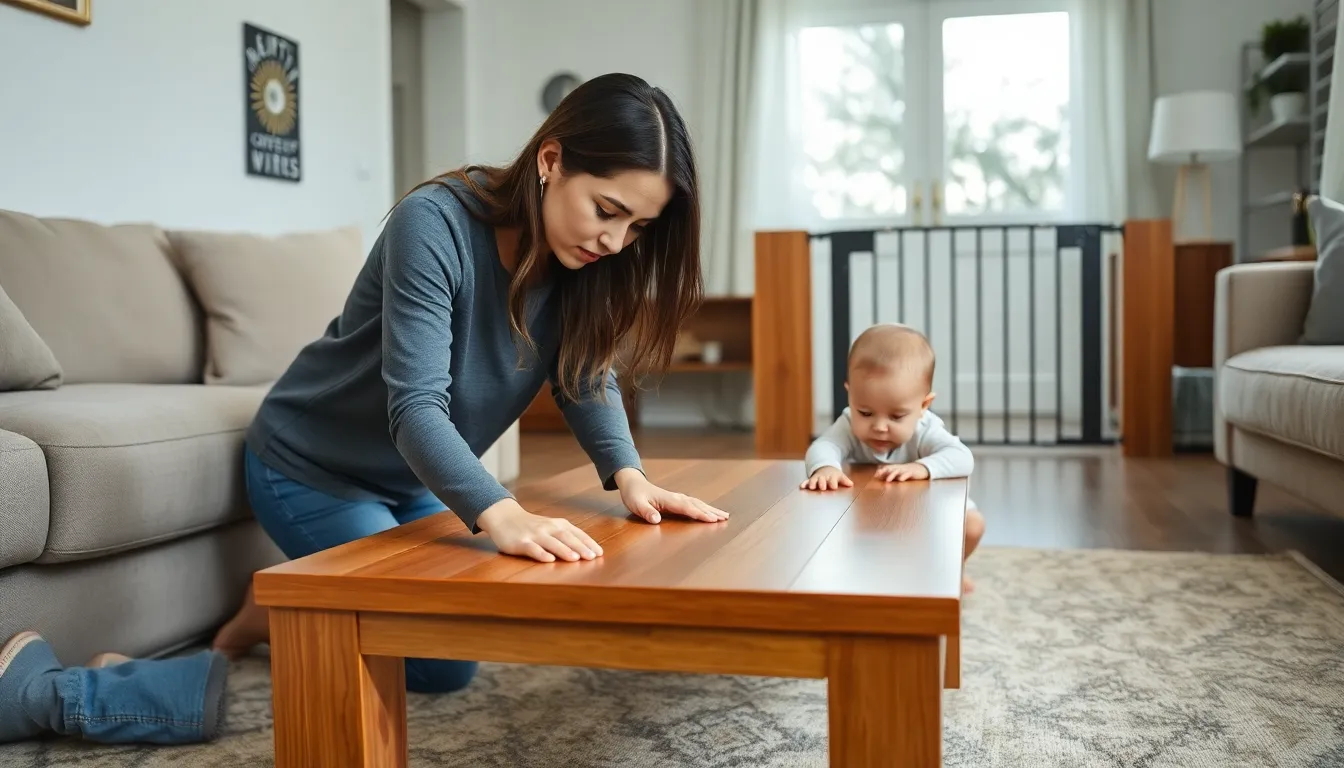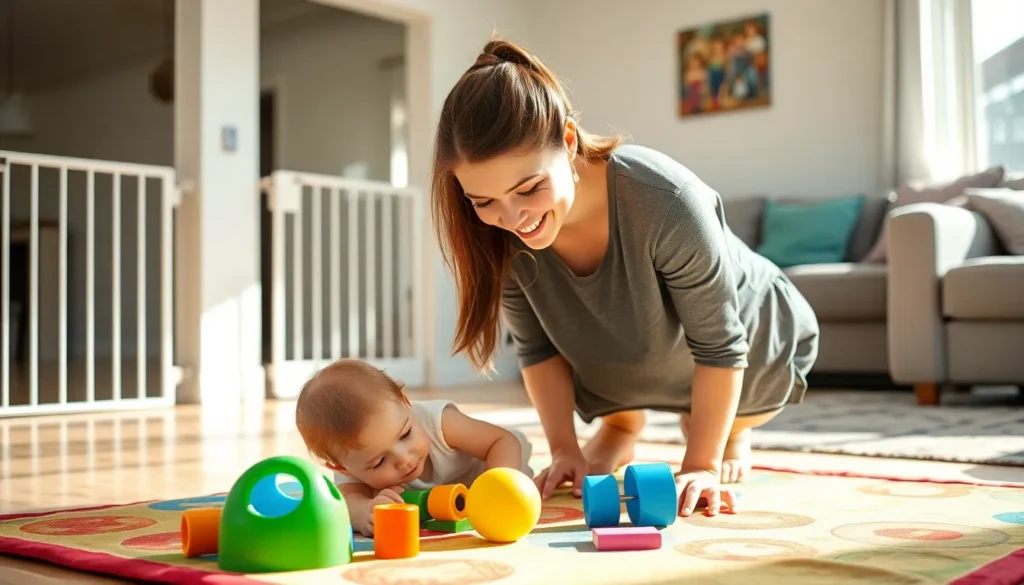Table of Contents
ToggleWelcoming a new baby into the home is an exciting time, but it also brings a host of challenges. One of the most crucial tasks for new parents is baby proofing their living space. As little ones begin to explore their surroundings, the risk of accidents increases, making it essential to create a safe environment.
Baby proofing involves more than just securing furniture and covering sharp edges. It’s about understanding a child’s natural curiosity and taking proactive steps to minimize hazards. From electrical outlets to choking hazards, every corner of the home can present potential dangers. By taking the right precautions, parents can ensure their child’s safety while fostering a space for exploration and growth.
What Is Baby Proofing?
Baby proofing refers to the process of making a home safe for infants and toddlers. It involves identifying and addressing potential hazards that may pose risks to children’s safety, especially as they begin to crawl, walk, and explore their environments.
Key components of baby proofing include:
- Securing Furniture: Anchor heavy furniture, like bookshelves and dressers, to walls to prevent tipping.
- Covering Sharp Edges: Use corner guards to protect against injuries from sharp furniture edges and corners.
- Installing Safety Gates: Place gates at the top and bottom of stairs to prevent falls.
- Blocking Access to Hazardous Areas: Keep dangerous areas, such as kitchens and bathrooms, out of reach using locks and gates.
- Safeguarding Electrical Outlets: Utilize outlet covers to prevent children from inserting objects into sockets.
- Eliminating Choking Hazards: Remove small objects and choke-prone items from floors and low surfaces.
Effective baby proofing requires ongoing evaluation, as children grow and develop new skills. It is essential to regularly reassess the environment to adapt to changing needs and ensure continued safety.
Why Baby Proofing Is Essential

Baby proofing ensures a safe environment for infants and toddlers, protecting them from common hazards as they explore their surroundings. Recognizing potential dangers and proactively addressing them is vital for new parents.
Common Household Hazards
Common household hazards include sharp corners, unsecured furniture, and toxic substances.
- Sharp corners: Unprotected furniture edges pose a significant risk for injury during exploration. Corner guards mitigate this threat effectively.
- Unsecured furniture: Heavy items like bookshelves can tip over if climbed upon. Anchoring these items to walls prevents potential accidents.
- Toxic substances: Cleaning supplies and medications often contain dangerous chemicals. Storing these out of reach or in locked cabinets eliminates risk.
- Electrical outlets: Exposed outlets represent a significant hazard. Outlet covers or safety plugs prevent children from inserting objects into them.
- Choking hazards: Small items like coins or batteries can cause choking. Regularly scanning the floor for these items keeps children safe.
The Developmental Stages of a Child
Understanding the developmental stages of a child helps anticipate safety needs and hazards.
- Infants (0-12 months): Infants crawl and explore with little awareness of danger. Safeguarding areas where they play and preventing access to stairs is essential.
- Toddlers (1-3 years): As toddlers begin walking, their curiosity grows. Installing safety gates at stairways and covering electrical outlets becomes crucial during this stage.
- Preschoolers (3-5 years): Preschoolers gain greater mobility and independence. Continuous evaluation of safety measures is necessary, as they reach for items and climb.
- Older children (5+ years): Although older children may be more aware of danger, supervision remains key. Teaching them about safety reinforces practices learned during earlier stages.
Regularly assessing a child’s abilities and exploring new environments ensures proactive safety measures adapt to their evolving skills.
Key Areas to Consider for Baby Proofing
Identifying key areas to focus on ensures comprehensive baby proofing. The following sections detail important safety measures for various spaces in the home.
Living Room Safety
Secure furniture such as bookcases and entertainment centers to walls to prevent tipping. Use corner guards on sharp furniture edges. Keep small items, like remote controls and batteries, out of reach. Limit access to cords from blinds and electronics, as they pose strangulation hazards. Maintain a clutter-free environment to reduce tripping risks. Arrange play areas with soft surfaces, ensuring that toys comply with safety standards.
Kitchen Safety
Store knives and sharp utensils in secured drawers or cabinets. Install safety latches on lower cabinets to restrict access to harmful substances and pots. Place heavy items on lower shelves to minimize the potential for injury from falling objects. Use stove knob covers to prevent accidental activation. Ensure that wires from small appliances are tucked away, eliminating tripping risks. Keep small appliances unplugged when not in use to prevent accidental activation.
Bathroom Safety
Install non-slip mats in the tub and on bathroom floors to prevent slips. Use toilet locks to prevent drowning risks. Store medications, toiletries, and cleaning products in high cabinets with safety latches. Ensure that all electrical outlets are covered to avoid electrical hazards. Use faucet covers to prevent burns from hot water. Supervise children closely during bath time to maintain safety.
Bedroom Safety
Anchor heavy furniture, including dressers and cribs, to prevent tipping. Remove any items from the crib that pose choking or strangulation hazards, such as blankets, pillows, and toys. Install a baby monitor to keep watch on sleeping infants. Use window guards to prevent falls from windows. Keep small furniture items and decor out of reach, ensuring they don’t obstruct safe movement in the room. Consider using cordless blinds for added safety.
Baby Proofing Products and Tools
Using the right baby proofing products and tools significantly enhances the safety of a home. Here are essential items that contribute to creating a secure environment for infants and toddlers.
Safety Gates and Barriers
Safety gates and barriers offer vital protection, blocking off access to stairs and hazardous areas. There are two primary types: pressure-mounted gates and hardware-mounted gates. Pressure-mounted gates work well in doorways and can easily be removed, while hardware-mounted gates are ideal for top of stairs, providing a more permanent solution. Selecting the appropriate type based on the installation area ensures effective space containment and child safety.
Outlets and Cords
Electrical outlet covers and cord organizers protect children from potential electrocution and choking hazards. Child-proof outlet covers prevent little fingers from accessing outlets, while sliding covers are convenient for adults. Cord management tools, such as cord wraps and clips, help keep cords out of reach, reducing strangulation risks. Regularly inspecting these products ensures they remain in place and effectively safeguard children from electrical hazards.
Cabinet Locks and Latches
Cabinet locks and latches secure cabinets and drawers, keeping hazardous items like medications, cleaning supplies, and sharp objects safely stored. Multiple lock types exist, including magnetic locks, sliding locks, and traditional hook-and-eye latches. Choosing a lock that fits the cabinet style and testing its functionality provides optimal safety. Regularly checking locks for wear ensures continued security against curious hands.
Creating a safe environment for a child is an ongoing journey that requires vigilance and adaptability. As infants grow into curious toddlers, their safety needs will change. Regularly reassessing the home and updating safety measures ensures that parents can provide a secure space for exploration.
Investing time and effort into baby proofing not only protects children from potential hazards but also fosters their development and independence. By understanding the evolving nature of child safety, parents can confidently navigate this exciting yet challenging phase of life. Prioritizing safety allows families to enjoy every precious moment without unnecessary worry.




